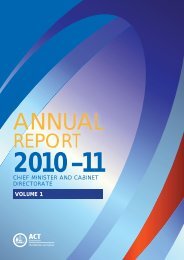Employment Strategy for People with Disability - Chief Minister and ...
Employment Strategy for People with Disability - Chief Minister and ...
Employment Strategy for People with Disability - Chief Minister and ...
- No tags were found...
Create successful ePaper yourself
Turn your PDF publications into a flip-book with our unique Google optimized e-Paper software.
STRATEGY<br />
ACT Public Service<br />
<strong>Employment</strong> <strong>Strategy</strong> <strong>for</strong><br />
<strong>People</strong> <strong>with</strong> <strong>Disability</strong><br />
‘Building an inclusive ACT Public Service’<br />
‘Feel inspired to make change’
ACT Public Service<br />
<strong>Employment</strong> <strong>Strategy</strong> <strong>for</strong><br />
<strong>People</strong> <strong>with</strong> <strong>Disability</strong><br />
‘Building an inclusive ACT Public Service’<br />
Commissioner <strong>for</strong> Public Administration 2011-2015<br />
This document provides a whole-of-government <strong>Employment</strong> <strong>Strategy</strong> <strong>for</strong> people <strong>with</strong> disability in the ACT Public Service.
STRATEGY<br />
Acknowledgements<br />
The ACT Public Service <strong>Employment</strong> <strong>Strategy</strong> <strong>for</strong> <strong>People</strong> <strong>with</strong> <strong>Disability</strong> has been<br />
developed <strong>with</strong> significant assistance from a range of key stakeholders <strong>with</strong> an<br />
interest in, <strong>and</strong> focus on, disability.<br />
Special thanks must go to those people <strong>with</strong> disability both <strong>with</strong>in the ACTPS <strong>and</strong><br />
those <strong>with</strong>in the community whose insights <strong>and</strong> work helps to facilitate access to<br />
employment opportunities <strong>for</strong> people <strong>with</strong> disability.<br />
Thank you to ACTPS Directorates that have contributed in the development process<br />
that will enable a one ACTPS approach to the employment of people <strong>with</strong> disability<br />
across the Service.<br />
Accessibility<br />
ACT Government is committed to making its in<strong>for</strong>mation, services, events <strong>and</strong> venues,<br />
accessible to as many people as possible.<br />
If you have difficulty reading a st<strong>and</strong>ard printed document <strong>and</strong> would like to receive<br />
this publication in a larger print <strong>for</strong>mat please telephone 6205 0649.<br />
If you are deaf or hearing impaired <strong>and</strong> require TTY typewriter service<br />
– please telephone 6205 0888.<br />
© Copyright ACT Public Service 2011.
Contents<br />
Acknowledgements ............................................................................2<br />
Accessibility ....................................................................................2<br />
Statement of Commitment .....................................................................4<br />
Introduction ...................................................................................5<br />
Purpose ........................................................................................6<br />
Our Vision ......................................................................................7<br />
Why develop an <strong>Employment</strong> <strong>Strategy</strong> <strong>for</strong> <strong>People</strong> <strong>with</strong> <strong>Disability</strong> in the ACTPS ..................8<br />
What is <strong>Disability</strong> ..............................................................................9<br />
Our Work<strong>for</strong>ce Challenges .....................................................................10<br />
Key Per<strong>for</strong>mance Measures ....................................................................12<br />
Measuring Success ............................................................................13<br />
Monitoring <strong>and</strong> Evaluation ....................................................................13<br />
Legislative Framework .........................................................................13<br />
Glossary .......................................................................................14<br />
Abbreviations .................................................................................16<br />
Bibliography ..................................................................................16<br />
Useful Links ...................................................................................17<br />
Action Plan ...................................................................................19<br />
1. To improve capability .....................................................................20<br />
2. To retain employees <strong>with</strong> disability in the ACTPS ...........................................21<br />
3. To attract employees <strong>with</strong> disability to the ACTPS ..........................................22<br />
High Level Indicators Reporting Tool to monitor progress .......................................23<br />
ACT Public Service | <strong>Employment</strong> <strong>Strategy</strong> 3
STRATEGY<br />
Statement of Commitment<br />
An important aim of the ACT Government is to make a positive difference in the lives of<br />
people <strong>with</strong> disability <strong>and</strong> their families. Providing genuine employment is a crucial part of<br />
enabling people <strong>with</strong> disability to have as independent a life as possible. This <strong>Employment</strong><br />
<strong>Strategy</strong> aims to build our confidence to employ people <strong>with</strong> disability in a great variety of<br />
roles across the Service.<br />
The ACT Government is committed to doubling the number of people <strong>with</strong> disability<br />
employed in the ACT Public Service by 2015. Quite simply we want the expertise<br />
<strong>and</strong> insights that people <strong>with</strong> disability can provide to improve Government policy<br />
development <strong>and</strong> service delivery. By focusing on abilities rather disabilities, by removing<br />
barriers, <strong>and</strong> by providing multiple employment pathways we will begin to increase the<br />
participation of people <strong>with</strong> disability in the Service.<br />
This 2011-2015 <strong>Employment</strong> <strong>Strategy</strong> <strong>for</strong>ms part of the ACT Public Service overarching<br />
Respect, Equity <strong>and</strong> Diversity Framework <strong>and</strong> establishes the actions to be used by<br />
Directorates to increase <strong>and</strong> maintain employment opportunities <strong>for</strong> people <strong>with</strong> disability.<br />
The ACT Public Service embraces diversity <strong>and</strong> promotes inclusion. This <strong>Employment</strong><br />
<strong>Strategy</strong> is about giving people <strong>with</strong> disability opportunities to realise their potential<br />
through access to employment in the ACT Public Service.<br />
Jon Stanhope MLA<br />
<strong>Chief</strong> <strong>Minister</strong><br />
<strong>People</strong> <strong>with</strong> disability have valuable skills <strong>and</strong> perspectives to offer our government <strong>and</strong> our<br />
community. By accessing this talent pool we will be better prepared to meet current <strong>and</strong><br />
predicted skills dem<strong>and</strong>s, while providing real opportunities <strong>for</strong> people <strong>with</strong> disability to<br />
realise their career aspirations.<br />
The <strong>Employment</strong> <strong>Strategy</strong> Action Plan details initiatives that will build employer <strong>and</strong><br />
employee confidence. Confidence to talk about differences; confidence to provide assistance<br />
<strong>and</strong> workplace adjustments; <strong>and</strong> confidence to remove workplace barriers so that the<br />
requirements of a diverse range of individuals can be met.<br />
This <strong>Employment</strong> <strong>Strategy</strong> articulates our commitment to building <strong>and</strong> developing expertise<br />
<strong>and</strong> confidence throughout the ACT Public Service to successfully attract, develop <strong>and</strong> retain<br />
people <strong>with</strong> disability in our work<strong>for</strong>ce.<br />
Catherine Hudson<br />
Commissioner <strong>for</strong> Public Administration
Introduction<br />
This <strong>Employment</strong> <strong>Strategy</strong> <strong>for</strong> <strong>People</strong> <strong>with</strong> <strong>Disability</strong> (the <strong>Employment</strong> <strong>Strategy</strong>) builds on the<br />
ACT Public Service (ACTPS) Respect, Equity <strong>and</strong> Diversity (RED) Framework <strong>and</strong> exp<strong>and</strong>s on the<br />
previous ACTPS <strong>Employment</strong> Framework <strong>for</strong> <strong>People</strong> <strong>with</strong> <strong>Disability</strong> 2004 by providing a focus on the<br />
employment of people <strong>with</strong> disability in the ACTPS.<br />
The RED Framework articulates the ACTPS’ commitment to creating a positive, respectful,<br />
supportive <strong>and</strong> fair work environment where employee 1 differences are respected, valued <strong>and</strong><br />
utilised to create a productive <strong>and</strong> collaborative workplace. Under the RED Framework there is<br />
recognition that more needs to be done in the ACTPS to attract, retain <strong>and</strong> support people <strong>with</strong><br />
disability in our work<strong>for</strong>ce. This <strong>Employment</strong> <strong>Strategy</strong> is a key initiative under the RED Framework<br />
Action Plan 2010-2012.<br />
This <strong>Employment</strong> <strong>Strategy</strong> <strong>for</strong>ms part of the ACTPS employment framework, together <strong>with</strong> the<br />
Public Sector Management Act 1994, the Human Rights Act 2004, the Discrimination Act 1991, the<br />
Commonwealth <strong>Disability</strong> Discrimination Act 1992, the Work Safety Act 2008, the Public Sector<br />
Management St<strong>and</strong>ards <strong>and</strong> ACTPS Enterprise Agreements.<br />
As a member of the Council of Australian Governments (COAG), the ACT Government has an<br />
important role to play in supporting the National <strong>Disability</strong> <strong>Strategy</strong> 2010-2020 <strong>and</strong> the National<br />
Mental Health <strong>and</strong> <strong>Disability</strong> <strong>Employment</strong> <strong>Strategy</strong>. An objective under both Strategies is to<br />
increase the employment of people <strong>with</strong> disability <strong>and</strong> mental illness 2 , promote social inclusion<br />
<strong>and</strong> improve national economic productivity.<br />
In 2009, the Department of <strong>Disability</strong>, Housing <strong>and</strong> Community Services launched Future Directions:<br />
Towards Challenge 2014 which is the ACT Government’s policy framework to improve outcomes<br />
<strong>and</strong> opportunities <strong>for</strong> Canberrans who have disability. The Framework guides priority areas <strong>for</strong><br />
disability policy <strong>and</strong> service delivery in the ACT through to 2014 <strong>and</strong> seeks to benefit all people<br />
<strong>with</strong> disability in the ACT. This <strong>Employment</strong> <strong>Strategy</strong> supports the Framework’s Strategic Priority<br />
of ‘I want to contribute to the community by engaging in public <strong>and</strong> private sector employment in<br />
work that suits my needs <strong>and</strong> abilities’.<br />
<strong>People</strong> <strong>with</strong> Disabilities ACT Incorporated<br />
(PWD ACT) released the report Making Diversity<br />
Work – a study of the employment of people <strong>with</strong><br />
disabilities in the ACTPS. The study undertaken<br />
by PWD ACT provided a comprehensive<br />
examination of the employment of people<br />
<strong>with</strong> disability in the ACTPS <strong>and</strong> the<br />
recommendations made in the report have<br />
provided a sound basis <strong>for</strong> the actions in this<br />
<strong>Employment</strong> <strong>Strategy</strong>.<br />
Did you know<br />
327 ACTPS employees identify as<br />
having a disability; or 1.6 per cent of the<br />
total ACTPS work<strong>for</strong>ce<br />
Commissioner <strong>for</strong> Public Administration,<br />
ACTPS Work<strong>for</strong>ce Profile 2009 -10<br />
1<br />
Employee means an officer or a casual employee or a temporary employee who is appointed<br />
to or engaged in the ACTPS under the PSM Act, 1994<br />
2<br />
In line <strong>with</strong> the National Mental Health <strong>and</strong> <strong>Disability</strong> <strong>Employment</strong> <strong>Strategy</strong>, <strong>for</strong> the purpose<br />
of this document, the term ‘people <strong>with</strong> disability’ also includes people <strong>with</strong> mental illness.<br />
ACT Public Service | <strong>Employment</strong> <strong>Strategy</strong> 5
STRATEGY<br />
Purpose<br />
The ACTPS aims to provide a workplace that embraces diversity, promotes inclusion <strong>and</strong><br />
enables people <strong>with</strong> disability to fulfill their potential as employees in the ACTPS.<br />
This <strong>Employment</strong> <strong>Strategy</strong> aims to remove barriers <strong>and</strong> increase access to employment<br />
opportunities <strong>and</strong> to assist in retaining <strong>and</strong> attracting people <strong>with</strong> disability to the ACTPS.<br />
We are committed to reporting on our progress <strong>and</strong> will provide an annual progress report<br />
to the <strong>Chief</strong> <strong>Minister</strong> on this <strong>Employment</strong> <strong>Strategy</strong> under the RED Framework’s monitoring<br />
<strong>and</strong> evaluation mechanism.<br />
The <strong>Employment</strong> <strong>Strategy</strong><br />
• Outlines the vision <strong>for</strong> the ACTPS.<br />
• Discusses why we need to develop an <strong>Employment</strong> <strong>Strategy</strong> <strong>for</strong> people <strong>with</strong> disability<br />
in the ACTPS.<br />
• Identifies the challenges facing the ACTPS in improving the employment outcomes <strong>for</strong><br />
people <strong>with</strong> disability.<br />
• Determines high level indicators of per<strong>for</strong>mance including a numerical target.<br />
• Outlines the objectives <strong>for</strong> employing people <strong>with</strong> disability in the ACTPS.<br />
• Determines actions to be undertaken to meet the identified challenges <strong>and</strong> deliver results.<br />
• Outlines how per<strong>for</strong>mance will be monitored <strong>and</strong> evaluated through an annual<br />
progress report (under the RED Framework) to the <strong>Chief</strong> <strong>Minister</strong>.<br />
• Outlines the legislative provisions supporting the employment of people <strong>with</strong> disability<br />
in the ACTPS.
Our Vision<br />
The <strong>Employment</strong> <strong>Strategy</strong>’s vision is that the ACTPS will be:<br />
‘A disability confident service, in which people <strong>with</strong> disability are able to access secure <strong>and</strong><br />
sustainable employment opportunities <strong>and</strong> are respected <strong>for</strong> their skills <strong>and</strong> capabilities.’<br />
<br />
To achieve this vision all ACT public servants have a role to undertake. Ef<strong>for</strong>ts to attract <strong>and</strong> retain<br />
employees <strong>with</strong> disability need to be increased significantly, perceived <strong>and</strong> actual barriers to<br />
promotion need to be addressed, <strong>and</strong> average remuneration levels need to be improved.<br />
A target of doubling the headcount of 30 June 2010 has been set. That is increasing from 1.6 per cent<br />
(327 self-identified employees) to 3.4 per cent (655 employees). 3<br />
Number of<br />
employees<br />
327<br />
Approximate numbers to<br />
be recruited per annum<br />
to meet target<br />
382<br />
55<br />
441<br />
59<br />
506<br />
65<br />
578<br />
72<br />
655 TARGET<br />
77<br />
CURRENT<br />
2010 2011 2012 2013 2014 2015<br />
Year<br />
3<br />
3.4 per cent refers to the percentage of employees based on the 30 June 2010 ACTPS headcount of 20,349.<br />
Figures refer to headcount, not Full Time Equivalents (FTE).<br />
ACT Public Service | <strong>Employment</strong> <strong>Strategy</strong> 7
STRATEGY<br />
Why develop an <strong>Employment</strong> <strong>Strategy</strong><br />
<strong>for</strong> <strong>People</strong> <strong>with</strong> <strong>Disability</strong> in the<br />
ACTPS<br />
The ACTPS recognises the range of skills, abilities <strong>and</strong> talent that people <strong>with</strong> disability bring<br />
to the workplace. Increasing the diversity of the ACTPS work<strong>for</strong>ce to more accurately reflect<br />
that of the community will provide opportunities <strong>for</strong> improved policy design, implementation<br />
<strong>and</strong> service delivery.<br />
The ACTPS Framework <strong>for</strong> <strong>People</strong> <strong>with</strong> a <strong>Disability</strong> 2004 aimed to ensure that people<br />
<strong>with</strong> disability were able to realise their potential through access to employment<br />
opportunities <strong>with</strong>in government. This <strong>Employment</strong> <strong>Strategy</strong> builds on the previous<br />
Framework. Initiatives such as the traineeship <strong>for</strong> people <strong>with</strong> an intellectual disability,<br />
introduced in 2010, further build <strong>and</strong> strengthen our capacity to employ people <strong>with</strong><br />
disability in the ACTPS.<br />
Work is essential to an individual’s economic security <strong>and</strong> is important to achieving social<br />
inclusion. <strong>Employment</strong> contributes to physical <strong>and</strong> mental health, personal wellbeing,<br />
sense of identity <strong>and</strong> economic security. 4 Work is the pathway used by most Australians<br />
to long-term economic security <strong>and</strong> wellbeing. Job retention <strong>and</strong> career development<br />
are also important. 5 The vast majority of people <strong>with</strong> disability can <strong>and</strong> do want to work<br />
<strong>and</strong> be as financially independent as possible, but employment is one critical area where<br />
Australia is lagging behind other countries. 6<br />
There are clear advantages <strong>and</strong> benefits to be achieved through the successful<br />
promotion of a disability employment re<strong>for</strong>m agenda, <strong>and</strong> compelling reasons to do so.<br />
Some benefits of employing <strong>and</strong> retaining people <strong>with</strong> disability include:<br />
• attracting <strong>and</strong> retaining a talented pool of employees;<br />
• improved customer service through a work<strong>for</strong>ce more representative of the ACT community;<br />
• strengthened workplace morale <strong>and</strong> productivity; <strong>and</strong><br />
• compliance <strong>with</strong> legislative requirements.<br />
The ACTPS Attraction <strong>and</strong> Retention Framework encourages ACTPS Directorates to ‘find<br />
<strong>and</strong> share innovative ways to underst<strong>and</strong> what the community needs <strong>and</strong> to deliver the<br />
services that meet those needs.’ Given that people <strong>with</strong> disability make up 14.2 per cent<br />
of the ACT population 7 <strong>and</strong> the ACTPS currently has only 327 employees <strong>with</strong> disability,<br />
or 1.6 per cent of the total ACTPS work<strong>for</strong>ce, employing people <strong>with</strong> disability in the<br />
ACTPS will help us to better underst<strong>and</strong> our community.<br />
4<br />
National <strong>Disability</strong> <strong>Strategy</strong> 2010-2020, p. 39.<br />
5<br />
National <strong>Disability</strong> <strong>Strategy</strong> 2010-2020, p. 39.<br />
6<br />
Organisation <strong>for</strong> Economic Co-operation <strong>and</strong> Development (OECD), Sickness, <strong>Disability</strong> <strong>and</strong> Work: keeping on track in the<br />
economic downturn-background paper, OECD, 2009, p. 12.<br />
7<br />
ABS 4430.0 – Survey of <strong>Disability</strong>, Ageing <strong>and</strong> Carers, 2003, DHCS Future Directions: Towards Challenge 2014.
Lack of accessible employment opportunities has resulted in higher levels of unemployment <strong>and</strong><br />
underemployment among people <strong>with</strong> disability in comparison <strong>with</strong> the rest of the Australian<br />
population. Labour-<strong>for</strong>ce participation <strong>for</strong> people <strong>with</strong> disability is 53 per cent, in contrast to 80<br />
per cent <strong>for</strong> people <strong>with</strong>out disability while only 35 per cent of Australians <strong>with</strong> disability receive<br />
their primary income through a wage, compared to 63 per cent of people <strong>with</strong>out disability. 8<br />
These figures indicate that the labour market participation of people <strong>with</strong> disability in Australia<br />
is low. <strong>People</strong> <strong>with</strong> disability represent a talented pool of available skill <strong>and</strong> ability which is<br />
currently under utilised.<br />
The ACTPS has an opportunity to improve employment outcomes <strong>for</strong> people <strong>with</strong> disability.<br />
As a public service <strong>and</strong> as a major employer in the ACT, we need to be a best practice organisation<br />
<strong>and</strong> one that leads the way <strong>for</strong> other organisations in the ACT community. To provide an increasing<br />
number of employment opportunities, the ACTPS needs to become disability confident.<br />
<strong>Disability</strong> confidence is:<br />
• Developing a better underst<strong>and</strong>ing of how people <strong>with</strong> disability relate to the organisation as<br />
potential <strong>and</strong> existing employees, as customers, suppliers <strong>and</strong> stakeholders;<br />
• Creating a culture of inclusion <strong>and</strong> removing barriers <strong>for</strong> people <strong>with</strong> disability;<br />
• Knowing how to make changes to recruitment practices to allow skilled <strong>and</strong> talented job<br />
seekers <strong>with</strong> disability to compete on a level playing field;<br />
• Empowering employees to tell us about their different abilities <strong>and</strong> tell us how we can better<br />
assist <strong>and</strong> support them in the workplace;<br />
• Employees being confident in the ACT Public Service’s ability to employ someone <strong>with</strong><br />
disability <strong>and</strong> the ACT Public Service being able to meet that employee’s needs:<br />
• Adjusting processes <strong>and</strong>/or services to enable individuals to contribute as employees,<br />
customers <strong>and</strong> stakeholders; <strong>and</strong><br />
• Knowing how to make adjustments to the workplace to retain employees who acquire disability.<br />
Adapted from the Australian Network on <strong>Disability</strong>, ‘Opportunity’, 2008.<br />
What is <strong>Disability</strong><br />
The term disability summarises a great number of different functional limitations occurring in any<br />
population in any country of the world. Persons <strong>with</strong> disability include those who have long-term<br />
physical, mental, intellectual or sensory impairments which in interaction <strong>with</strong> various barriers hinder<br />
their full <strong>and</strong> effective participation in society on an equal basis <strong>with</strong> others. 9 The Australian Bureau<br />
of Statistics (ABS) defines a person as having a disability if the person has one or more impairments<br />
8<br />
ABS 2003, cited in ‘The way <strong>for</strong>ward – a new disability policy framework <strong>for</strong> Australia’ FaHCSIA.<br />
9<br />
United Nations St<strong>and</strong>ard Rules on the Equalization of Opportunities <strong>for</strong> Persons <strong>with</strong> Disabilities.<br />
ACT Public Service | <strong>Employment</strong> <strong>Strategy</strong> 9
STRATEGY<br />
that impact on their daily life <strong>and</strong> lasts <strong>for</strong> six months or longer. The key aspect is not the<br />
impairment, but its effect. <strong>Disability</strong> can be anything from migraines to arthritis, from<br />
dyslexia to back pain. 10<br />
In defining disability, we recognise the diversity of people <strong>with</strong> disability. <strong>People</strong> <strong>with</strong><br />
disability may have specific needs, priorities <strong>and</strong> perspectives based on their personal<br />
circumstances, including the type <strong>and</strong> level of support required, education, gender, age,<br />
sexuality, <strong>and</strong> ethnic or cultural background. Some experience multiple disadvantages.<br />
Gender, race <strong>and</strong> age can significantly impact on the experience of disability. 11 Some<br />
people <strong>with</strong> a disability need relatively little support <strong>and</strong> do not access any specialist<br />
employment support system.<br />
These considerations in conjunction <strong>with</strong> the definition provided in the <strong>Disability</strong><br />
Discrimination Act 1992 will guide how we collect <strong>and</strong> analyse our disability data <strong>and</strong><br />
will in<strong>for</strong>m the development of the whole-of-ACTPS Diversity Census. 12<br />
Our Work<strong>for</strong>ce Challenges<br />
In alignment <strong>with</strong> the ACTPS Attraction <strong>and</strong> Retention <strong>and</strong> RED Frameworks, this<br />
<strong>Employment</strong> <strong>Strategy</strong> aims to meet three key objectives that will assist us to become<br />
a disability confident organisation:<br />
Retain<br />
Capability<br />
Attract<br />
<strong>Disability</strong><br />
Confidence<br />
What this means <strong>for</strong> improving our capability to employ people <strong>with</strong> disability in the ACTPS:<br />
• Improving the capability of the ACTPS to respond positively to applicants <strong>and</strong><br />
employees <strong>with</strong> disability.<br />
• Building the capability <strong>and</strong> confidence of our managers <strong>and</strong> supervisors to be able to<br />
underst<strong>and</strong> <strong>and</strong> manage employees <strong>with</strong> disability.<br />
• Looking at new ways of working from initial job design through to flexible ways of working.<br />
10<br />
Australian Network on <strong>Disability</strong>, ‘Opportunity’ 2008.<br />
11<br />
National <strong>Disability</strong> <strong>Strategy</strong> 2010-2020, p. 12.<br />
12<br />
Data collected <strong>for</strong> this purpose would be de-identified <strong>and</strong> the in<strong>for</strong>mation<br />
held appropriately in line <strong>with</strong> legislative requirements.
• Ongoing analysis of our work<strong>for</strong>ce data to in<strong>for</strong>m<br />
work<strong>for</strong>ce planning <strong>and</strong> to ensure access to<br />
employment.<br />
• Providing learning <strong>and</strong> development<br />
opportunities <strong>for</strong> employees <strong>with</strong> disability.<br />
• Making relevant workplace adjustments to meet<br />
the needs of employees <strong>with</strong> disability.<br />
• Accessing resources that assist in supporting<br />
employees <strong>with</strong> disability.<br />
• Supporting managers <strong>and</strong> supervisors through<br />
in<strong>for</strong>mation <strong>and</strong> guidance.<br />
What this means <strong>for</strong> retaining our employees<br />
<strong>with</strong> disability in the ACTPS:<br />
• Building a positive work culture in the ACTPS<br />
that recognises the contribution of people <strong>with</strong><br />
disability <strong>and</strong> supports employees to tell us about<br />
their disability <strong>and</strong> needs.<br />
• Supporting managers <strong>and</strong> supervisors to<br />
implement flexible employment arrangements to<br />
support employees <strong>with</strong> disability in the ACTPS.<br />
• Raising awareness <strong>and</strong> challenging incorrect<br />
assumptions about people <strong>with</strong> disability.<br />
• Enabling employees <strong>with</strong> disability to access higher duties, learning opportunities <strong>and</strong> gain<br />
support when applying <strong>for</strong> positions <strong>with</strong>in the ACTPS.<br />
• Promoting flexible employment arrangements that enable people <strong>with</strong> disability to participate.<br />
• Providing in<strong>for</strong>mation in an accessible <strong>for</strong>mat.<br />
• Encouraging employees <strong>with</strong> disability to comment on employment practices in the ACTPS.<br />
What this means <strong>for</strong> attracting people <strong>with</strong> disability to the ACTPS:<br />
Did You Know<br />
• An Australian Government review<br />
found that workers <strong>with</strong> disability<br />
are no more likely to be injured at<br />
work than any other employee.<br />
• Studies have found no difference in<br />
per<strong>for</strong>mance <strong>and</strong> productivity, <strong>and</strong><br />
found that employees <strong>with</strong> disability<br />
actually have fewer scheduled<br />
absences than employees <strong>with</strong>out<br />
disability as well as increased tenure.<br />
• On average, employing people<br />
<strong>with</strong> disability does not cost any<br />
more than employing people<br />
<strong>with</strong>out disability.<br />
• Assistance <strong>with</strong> the cost of making<br />
workplace adjustments is available<br />
through the Australian Government.<br />
Adapted from the Australian Network on<br />
<strong>Disability</strong>, ‘Opportunity’, 2008.<br />
• Developing practices <strong>and</strong> culture to enable the ACTPS to be an ‘employer of choice’ <strong>for</strong> people<br />
<strong>with</strong> disability.<br />
• Removing barriers that may hinder people <strong>with</strong> disability seeking employment in the ACTPS.<br />
• Reviewing our job design processes to ensure access to opportunities <strong>for</strong> people <strong>with</strong> disability.<br />
• Modifying duty statements <strong>and</strong> job descriptions to accommodate people <strong>with</strong> disability.<br />
• Increasing awareness <strong>for</strong> people <strong>with</strong> disability of employment opportunities, through<br />
<strong>Disability</strong> Networks.<br />
ACT Public Service | <strong>Employment</strong> <strong>Strategy</strong> 11
STRATEGY<br />
Key Per<strong>for</strong>mance Measures<br />
A number of actions to enable the ACTPS to meet the key challenges are outlined in the<br />
<strong>Employment</strong> <strong>Strategy</strong> Action Plan (Appendix A). To measure the effectiveness of those<br />
actions <strong>and</strong> this <strong>Employment</strong> <strong>Strategy</strong>, high level indicators have been developed that<br />
align <strong>with</strong> the objectives of improving capability, retaining <strong>and</strong> attracting employees.<br />
These per<strong>for</strong>mance measures align <strong>with</strong> the indicators in the National <strong>Disability</strong> <strong>Strategy</strong><br />
2010-2020 which include:<br />
• proportion of people <strong>with</strong> disability participating in the labour <strong>for</strong>ce;<br />
• proportion of people <strong>with</strong> disability in both private <strong>and</strong> public sector employment; <strong>and</strong><br />
• difference between the average income <strong>for</strong> all Australians. 13<br />
Improving our capability<br />
1. Reports on the achievements of this <strong>Employment</strong> <strong>Strategy</strong> (as outlined in the<br />
Action Plan <strong>and</strong> Directorate Action Plans) are provided to the <strong>Chief</strong> <strong>Minister</strong> in<br />
accordance <strong>with</strong> the annual progress report requirements under the ACTPS RED<br />
Framework.<br />
Retaining employees <strong>with</strong> disability in the ACTPS<br />
2. The difference in representation of people <strong>with</strong> disability across ACTPS<br />
classifications <strong>and</strong> levels, as measured by average remuneration is<br />
progressively reduced. 14<br />
3. The number <strong>and</strong> percentage share of ACTPS permanent employees that have<br />
disability who leave the service is progressively reduced. 15<br />
4. All employees <strong>with</strong> disability in the ACTPS have learning <strong>and</strong> development/career plans.<br />
Attracting people <strong>with</strong> disability to the ACTPS<br />
5. The percentage share of the ACTPS comprised of people <strong>with</strong> disability progressively<br />
increases from 327 employees (or 1.6 per cent) to 655 employees (or 3.4 per cent)<br />
16, 17<br />
by 2015.<br />
6. The number <strong>and</strong> percentage share of new ACTPS permanent employees recruited<br />
who have disability is progressively increased.<br />
13<br />
National <strong>Disability</strong> <strong>Strategy</strong> 2010-2020, p. 61.<br />
14<br />
This indicator aims to show that career opportunities <strong>and</strong> outcomes <strong>for</strong> people <strong>with</strong> disability are non-discriminatory<br />
<strong>and</strong> consistent across the whole of the ACTPS work<strong>for</strong>ce.<br />
15<br />
This indicator refers to the lowering of the separation rate <strong>for</strong> employees <strong>with</strong> disability in the ACTPS.<br />
16<br />
3.4 per cent refers to the percentage of employees based on the 30 June 2010 ACTPS headcount figure of 20,349.<br />
17<br />
Figures refer to headcount, not Full Time Equivalents (FTE).
Measuring Success<br />
The key indicators <strong>for</strong> measuring the success of the <strong>Employment</strong> <strong>Strategy</strong> are:<br />
• implementation of the actions that underpin this <strong>Employment</strong> <strong>Strategy</strong> <strong>and</strong> their outcomes;<br />
• improved per<strong>for</strong>mance against the key per<strong>for</strong>mance measures outlined in this <strong>Employment</strong> <strong>Strategy</strong>; <strong>and</strong><br />
• increased reporting of disability status across the Service – indicating individuals in the workplace<br />
feel more com<strong>for</strong>table to tell us about their disability.<br />
Monitoring <strong>and</strong> Evaluation<br />
Monitoring <strong>and</strong> evaluating our per<strong>for</strong>mance is a key component of ensuring that the capacity <strong>and</strong><br />
capability of the ACTPS to attract <strong>and</strong> retain people <strong>with</strong> disability is continually improving <strong>and</strong> that<br />
learning <strong>and</strong> development opportunities are provided <strong>for</strong> employees <strong>with</strong> disability.<br />
As a component of the annual RED progress report to the <strong>Chief</strong> <strong>Minister</strong>, an update will be provided<br />
against the key per<strong>for</strong>mance measures outlined in this <strong>Employment</strong> <strong>Strategy</strong> along <strong>with</strong> a progress<br />
report on the implementation of the Action Plan <strong>and</strong> Directorate Action Plans.<br />
Legislative Framework<br />
All Directors-General, Directorates <strong>and</strong> employees have obligations under Federal <strong>and</strong> Territory<br />
legislation to actively ensure equity in access to employment <strong>and</strong> career development opportunities.<br />
Section 40 of the PSM Act requires the development of equal employment opportunity programs <strong>and</strong><br />
Section 65 provides <strong>for</strong> modified selection processes in cases of identified positions.<br />
Equal <strong>Employment</strong> Opportunity (EEO) programs must be designed to ensure that action is taken<br />
to eliminate discrimination in employment matters <strong>and</strong> enable people in designated groups<br />
to compete <strong>for</strong> promotion, <strong>and</strong> transfer <strong>and</strong> pursue careers in the ACTPS as effectively as other<br />
people. Relevant legislation includes:<br />
ACT Legislation<br />
- Discrimination Act 1991<br />
- Human Rights Act 2004<br />
- Legislative Assembly (Member’s Staff) Act 1998<br />
- Public Sector Management Act 1994<br />
- Territory Records Act 2002<br />
- Work Safety Act 2008<br />
COMMONWEALTH Legislation<br />
- <strong>Disability</strong> Discrimination Act 1992<br />
- Equal <strong>Employment</strong> Opportunity <strong>for</strong> Women in the<br />
Workplace Act 1999<br />
- Fair Work Act 2009<br />
- Health Records (Privacy <strong>and</strong> Access) Act 1997<br />
- Privacy Act 1998<br />
- United Nations Convention on the Rights of Persons<br />
<strong>with</strong> <strong>Disability</strong> (UN CRPD)<br />
Note: Amendments to the Human Rights Framework allows the ACT Human Rights Commission<br />
to hold public sector authorities accountable <strong>for</strong> their adherence to human rights principles.<br />
ACT Public Service | <strong>Employment</strong> <strong>Strategy</strong> 13
STRATEGY<br />
Glossary<br />
<strong>Disability</strong> Discrimination<br />
Act 1992 definition of<br />
<strong>Disability</strong><br />
The <strong>Disability</strong> Discrimination Act 1992 defines disability,<br />
in relation to a person, as:<br />
• total or partial loss of the person’s bodily or mental<br />
functions;<br />
• total or partial loss of a part of the body;<br />
• the presence in the body of organisms causing disease<br />
or illness;<br />
• the presence in the body of organisms capable of<br />
causing disease or illness;<br />
• the malfunction, mal<strong>for</strong>mation or disfigurement of a<br />
part of the person’s body;<br />
• a disorder or malfunction that results in the person<br />
learning differently from a person <strong>with</strong>out the<br />
disorder or malfunction; <strong>and</strong>/or<br />
• a disorder, illness or disease that affects a person’s<br />
thought processes, perception of reality, emotions<br />
or judgment or that results in disturbed behaviour<br />
<strong>and</strong> includes a disability that:<br />
- presently exists;<br />
- previously existed but no longer exists;<br />
- may exist in the future; <strong>and</strong><br />
- is imputed to a person.<br />
EEO<br />
Employee<br />
FTE<br />
Equal <strong>Employment</strong> Opportunity.<br />
Employee means an officer or a casual employee<br />
or a temporary employee who is appointed to<br />
or engaged in the ACTPS under the Public Sector<br />
Management Act 1994.<br />
‘Full-time Equivalent’ is the number of hours worked<br />
by part-time or casual staff expressed as a proportion<br />
of the st<strong>and</strong>ard award hours worked by equivalent<br />
full-time staff. For example, staff who worked half the<br />
st<strong>and</strong>ard hours applicable to their award would attract<br />
an FTE of 0.5.
Headcount<br />
Reasonable adjustment<br />
A headcount of the number of staff who were paid at the date of<br />
data capture. Headcount figures exclude employees who were<br />
not paid in the reporting <strong>for</strong>tnight.<br />
Making changes to ensure equal opportunity <strong>for</strong> people<br />
<strong>with</strong> a disability is commonly referred to as ‘reasonable<br />
adjustment’ or ‘reasonable accommodation’. For many people<br />
<strong>with</strong> disability, a major barrier to equal opportunity, equal<br />
participation or equal per<strong>for</strong>mance at work is some feature of<br />
the work situation which could readily be altered. Removal of<br />
discrimination as required by the <strong>Disability</strong> Discrimination Act<br />
1992 <strong>and</strong> the Discrimination Act 1991, requires removing this<br />
kind of barrier, not just more obvious or direct discrimination<br />
based on disability. 18<br />
In addition, a reasonable adjustment, also called a workplace<br />
adjustment, is whatever is considered necessary, achievable <strong>and</strong><br />
reasonable to enable the employee to per<strong>for</strong>m their job role<br />
efficiently <strong>and</strong> to the best of their abilities.<br />
This could include, but is not limited to:<br />
• Work station access <strong>and</strong> adjustments: changes to work area<br />
design <strong>and</strong> means of access to the workplace <strong>and</strong> all facilities,<br />
modifications to technology <strong>and</strong> equipment;<br />
• Hiring practices: changes to the procedures used <strong>for</strong> testing,<br />
selection, training, promotion <strong>and</strong> termination;<br />
• Work procedure adjustments: modifications to the specific<br />
requirements of a particular job, restructuring of duties,<br />
modifications to working hours, adoption of flexible work<br />
practices, flexible hours <strong>and</strong> leave options;<br />
• Provision of specific services, facilities, aids or equipment:<br />
including the provision of interpreters, particular equipment,<br />
attendant service, or assistance <strong>with</strong> particular aspects of<br />
a job; <strong>and</strong><br />
• Reassignment of an individual employee: a change of position<br />
or the reassignment of specific tasks to another position. 19<br />
Work <strong>and</strong> Life Balance<br />
The concept of work <strong>and</strong> life balance recognises that all<br />
employees have commitments outside the workplace. These<br />
commitments may relate to their family, to the community <strong>and</strong>/<br />
or to their general health <strong>and</strong> wellbeing.<br />
18<br />
Adapted from the Department of Immigration <strong>and</strong> Citizenship: Workplace Diversity Plan 2008-2010.<br />
19<br />
‘A Place <strong>for</strong> All: A Guide to Creating an Inclusive Workplace’ Canadian Human Rights Commission.<br />
ACT Public Service | <strong>Employment</strong> <strong>Strategy</strong> 15
STRATEGY<br />
Abbreviations<br />
ABS<br />
Australian Bureau of Statistics<br />
ACT<br />
Australian Capital Territory<br />
ACTPS<br />
Australian Capital Territory Public Service<br />
AND<br />
CMD<br />
COAG<br />
CSD<br />
PSM Act<br />
PWD ACT Inc<br />
Australian Network on <strong>Disability</strong><br />
<strong>Chief</strong> <strong>Minister</strong>’s Directorate<br />
Council of Australian Governments<br />
Community Services Directorate<br />
Public Sector Management Act 1994 (ACT)<br />
<strong>People</strong> <strong>with</strong> Disabilities Australian Capital Territory<br />
Incorporated<br />
Bibliography<br />
1. ‘A Place <strong>for</strong> All: A Guide to Creating an Inclusive Workplace’ Canadian Human<br />
Rights Commission.<br />
2. Australian Chamber of Commerce <strong>and</strong> Industry’s Plan <strong>for</strong> the employment of people<br />
<strong>with</strong> a disability – June 2008.<br />
3. Australian Employers’ Network on <strong>Disability</strong> factsheet “Business Benefits of Employing<br />
people <strong>with</strong> a <strong>Disability</strong>”.<br />
4. Australian Government, Management Advisory Committee “<strong>Employment</strong> of <strong>People</strong> <strong>with</strong><br />
<strong>Disability</strong> in the APS”, 2006.<br />
5. Australian Network on <strong>Disability</strong>, Sydney Seminar February 2009 - Action to <strong>Strategy</strong> or<br />
<strong>Strategy</strong> to Action – IBM Australia.<br />
6. Australian Network on <strong>Disability</strong>, ‘Opportunity’, 2008.<br />
7. Department of Immigration <strong>and</strong> Citizenship: Workplace Diversity Plan 2008-2010.<br />
8. Graffam et al, ‘Employer benefits <strong>and</strong> Costs of Employing a Person <strong>with</strong> a <strong>Disability</strong>’ <strong>and</strong><br />
‘Factors that influence Employer Decisions in Hiring <strong>and</strong> Retaining an Employee <strong>with</strong> a<br />
<strong>Disability</strong>’ J. Graffam ‘Good News <strong>and</strong> Good Business’, Disparity, Summer, 2002.<br />
9. National <strong>Disability</strong> <strong>Strategy</strong>, Council of Australian Governments – 2010-2020.<br />
10. National Mental Health <strong>and</strong> <strong>Disability</strong> <strong>Employment</strong> <strong>Strategy</strong> – 2009.
11. Organisation <strong>for</strong> Economic Co-operation <strong>and</strong> Development (OECD), Sickness, <strong>Disability</strong> <strong>and</strong> Work:<br />
keeping on track in the economic downturn-background paper, OECD, 2009.<br />
12. <strong>People</strong> <strong>with</strong> Disabilities ACT Inc “Making Diversity Work – A study of employment of people <strong>with</strong><br />
disabilities”, 2009.<br />
13. Shut Out: The Experience of <strong>People</strong> <strong>with</strong> Disabilities <strong>and</strong> their Families in Australia, National<br />
<strong>Disability</strong> <strong>Strategy</strong> Consultation Report prepared by the National <strong>People</strong> <strong>with</strong> Disabilities <strong>and</strong><br />
Carer Council.<br />
14. United Nations Convention on the Rights of Persons <strong>with</strong> <strong>Disability</strong> (UN CRPD), Article 1.<br />
15. Western Australian Public Sector, Employing <strong>People</strong> <strong>with</strong> Disabilities, ‘Showing the Way’.<br />
Useful Links<br />
ACT <strong>Disability</strong> Advisory Council<br />
http://www.dhcs.act.gov.au/disability_act/disability_advisory_council<br />
ACT Human Rights Commission<br />
http://www.hrc.act.gov.au<br />
ACT Public Service Enterprise Agreements<br />
http://www.sharedservices.act.gov.au/docs/agreements/<br />
ACT Public Service Jobs Website<br />
www.jobs.act.gov.au<br />
ACT Public Service Respect at Work Policy <strong>and</strong> Preventing Work Bullying Guidelines <strong>and</strong><br />
Open Door Protocol<br />
http://www.cmd.act.gov.au/governance/public/publications#red<br />
ACT Public Service Respect, Equity <strong>and</strong> Diversity Framework<br />
http://www.cmd.act.gov.au/governance/public/RED<br />
ACT Public Service Work<strong>for</strong>ce Profile<br />
http://www.cmd.act.gov.au/governance/public/publications<br />
ACT Work Safety<br />
http://www.worksafety.act.gov.au/health_safety<br />
Annual Report Directions 2007-2010<br />
http://www.legislation.act.gov.au/ni/2010-308/current/pdf/2010-308.pdf<br />
Australian Network on <strong>Disability</strong><br />
http://www.<strong>and</strong>.org.au<br />
Commonwealth Rehabilitation Services (CRS)<br />
http://www.crsaustralia.gov.au<br />
ACT Public Service | <strong>Employment</strong> <strong>Strategy</strong> 17
STRATEGY<br />
Community Services Directorate – <strong>Disability</strong> ACT<br />
http://www.dhcs.act.gov.au/disability_act<br />
Department of Families, Housing, Community Services <strong>and</strong> Indigenous Affairs (FaHCSIA)<br />
http://www.fahcsia.gov.au<br />
<strong>Disability</strong> ACT – Access Resource Guide 2010<br />
http://www.dhcs.act.gov.au/__data/assets/pdf_file/0006/172581/Access_Resource_Guide_FINAL.pdf<br />
<strong>Disability</strong> ACT – Engaging Canberrans<br />
http://www.dhcs.act.gov.au/__data/assets/pdf_file/0008/172592/Engaging_<strong>People</strong>_<strong>with</strong>_<strong>Disability</strong>.pdf<br />
<strong>Disability</strong> <strong>Employment</strong> Services<br />
http://www.deewr.gov.au/<strong>Employment</strong>/Programs/DES/Pages/default.aspx<br />
<strong>Disability</strong> Services Australia<br />
http://www.dsa.org.au/Home.aspxelement=1&category=1<br />
<strong>Disability</strong> Works Australia<br />
http://www.dwa.org.au<br />
Human Rights Act 2004<br />
http://www.legislation.act.gov.au/a/2004-5/default.asp<br />
Job Access<br />
http://www.jobaccess.gov.au<br />
<strong>People</strong> <strong>with</strong> Disabilities ACT Incorporated<br />
http://www.pwdact.org.au<br />
Public Sector Management Act 1994<br />
http://www.legislation.act.gov.au/a/1994-37/default.asp<br />
Public Sector Management St<strong>and</strong>ards<br />
http://www.legislation.act.gov.au/di/2006-187/default.asp
Appendix A<br />
<strong>Employment</strong> <strong>Strategy</strong> <strong>for</strong><br />
<strong>People</strong> <strong>with</strong> <strong>Disability</strong><br />
Action Plan<br />
The <strong>Employment</strong> <strong>Strategy</strong> <strong>for</strong> <strong>People</strong> <strong>with</strong> <strong>Disability</strong> Action Plan outlines actions to enable the<br />
objectives of the <strong>Employment</strong> <strong>Strategy</strong> to be met.<br />
To help define the actions required, initiatives <strong>and</strong> actions have been outlined under key areas,<br />
aligned to the objectives contained in the <strong>Employment</strong> <strong>Strategy</strong> including:<br />
Retain<br />
Capability<br />
Attract<br />
<strong>Disability</strong><br />
Confidence<br />
How this Action Plan works:<br />
This Action Plan is aligned <strong>with</strong> the RED Framework Action Plan. The Action Plan:<br />
• determines initiatives/actions;<br />
• notes who is responsible <strong>for</strong> completion of the actions;<br />
• enables Directorates to define other actions to meet their specific work<strong>for</strong>ce challenges;<br />
• provides a reporting tool to monitor progress against the high level indicators; <strong>and</strong><br />
• <strong>for</strong>ms a component of the annual Respect, Equity <strong>and</strong> Diversity progress report to the<br />
<strong>Chief</strong> <strong>Minister</strong>.<br />
Actions highlighted in<br />
should be contained in each Directorate’s <strong>Employment</strong><br />
<strong>Strategy</strong> <strong>for</strong> <strong>People</strong> <strong>with</strong> <strong>Disability</strong> Action Plan. The inclusion of other actions will depend on<br />
the size of the Directorate, the programs it offers, the type <strong>and</strong> number of clients it services,<br />
<strong>and</strong> available resources.<br />
ACT Public Service | <strong>Employment</strong> <strong>Strategy</strong> 19
APPENDIX A<br />
1. To improve capability<br />
Actions Responsibility Progress<br />
Co-ordination initiatives including:<br />
• Providing in<strong>for</strong>mation, advice <strong>and</strong> guidance to managers <strong>and</strong> supervisors on assistance available when<br />
employing people <strong>with</strong> disability; <strong>and</strong><br />
• Promoting the ACTPS <strong>and</strong> providing advice to current <strong>and</strong> potential employees about applying <strong>for</strong> <strong>and</strong> working<br />
in the ACTPS.<br />
WHoG <strong>Chief</strong> <strong>Minister</strong>s<br />
Directorate (CMD) Public<br />
Sector Management Group /<br />
Community Services Directorate<br />
(CSD) / All Directorates<br />
Investigating training initiatives including:<br />
• Delivery of disability awareness training across the ACTPS;<br />
• Delivery of supervisor/manager disability awareness <strong>and</strong> refresher training;<br />
• Mental health awareness training as part of learning <strong>and</strong> development programs;<br />
• Potential involvement of ACTPS employees <strong>with</strong> disability to contribute to disability awareness training;<br />
• Developing <strong>and</strong> incorporating appropriate disability awareness content <strong>with</strong>in the ACTPS on-line induction<br />
package <strong>and</strong> RED training initiatives; <strong>and</strong><br />
• Requiring prospective tenderers <strong>for</strong> provision of learning <strong>and</strong> development programs to provide programs in<br />
accessible <strong>for</strong>mats, <strong>and</strong> to tailor these as appropriate <strong>for</strong> participants.<br />
WHoG CMD Public Sector<br />
Management Group /<br />
All Directorates /<br />
Shared Services<br />
Accessibility initiatives including:<br />
• Undertaking regular Accessibility Audits;<br />
• Promoting <strong>Disability</strong> ACT’s Access Resource Guide; <strong>and</strong><br />
• Promoting <strong>Disability</strong> ACT’s Engaging Canberrans: A guide to engaging <strong>and</strong> communicating <strong>with</strong> people <strong>with</strong> disability.<br />
All Directorates<br />
Developing <strong>and</strong> participating in an ACT-based accreditation scheme <strong>for</strong> inclusive <strong>and</strong> welcoming employers<br />
(BLITS tick scheme).<br />
CSD <strong>Disability</strong> ACT/<br />
All Directorates<br />
Policy/in<strong>for</strong>mation/research initiatives including:<br />
• Reviewing <strong>and</strong> updating the online ACTPS <strong>Disability</strong> Toolkit;<br />
• Developing, implementing <strong>and</strong> promoting a Reasonable Adjustments policy <strong>and</strong> procedures; <strong>and</strong><br />
• Undertaking further research into episodic disability, such as chronic illness <strong>and</strong> mental illness.<br />
WHoG CMD Public Sector<br />
Management Group<br />
Monitoring <strong>and</strong> Reporting initiatives including:<br />
WHoG CMD Public Sector<br />
• Holding annual stakeholder meetings to discuss progress in implementation of this <strong>Employment</strong> <strong>Strategy</strong>; <strong>and</strong> Management Group<br />
• Analysing ACTPS work<strong>for</strong>ce data such as the Work<strong>for</strong>ce Profile, the annual (Agency) Directorate Survey <strong>and</strong> the RED<br />
Progress report to the <strong>Chief</strong> <strong>Minister</strong> to determine success in employing people <strong>with</strong> disability to the ACTPS. 20<br />
20<br />
Note: Under the RED Framework Action Plan 2010-2012, preliminary investigation of an ‘Employee Survey’ that incorporates RED matters will be undertaken.
2. To retain employees <strong>with</strong> disability in the ACTPS<br />
Actions Responsibility Progress<br />
Investigate extending the provision of professional development opportunities to employees <strong>with</strong> disability<br />
including:<br />
• Career plans/Learning <strong>and</strong> Developments Plans;<br />
• Participation on management development programs;<br />
• Coaching;<br />
• Mentoring programs; <strong>and</strong><br />
• Participating in professional practice networks.<br />
WHoG CMD Public Sector<br />
Management Group CMD /<br />
All Directorates<br />
Assist employees across the ACTPS to build ‘disability confidence’ as co-workers, managers <strong>and</strong> hirers of people<br />
<strong>with</strong> disability <strong>and</strong> provide practical ideas <strong>and</strong> tools to make a difference on the ground.<br />
All Directorates<br />
Actively promote <strong>and</strong> recognise International Day of <strong>People</strong> <strong>with</strong> <strong>Disability</strong>. All Directorates<br />
Promote flexible working conditions <strong>and</strong> reasonable adjustments available to ACTPS employees. All Directorates<br />
Raise awareness of the obligations of the <strong>Disability</strong> Discrimination Act 1992, the Discrimination Act 1991 <strong>and</strong><br />
Human Rights Act 2004 across the ACTPS.<br />
All Directorates<br />
Establish a professional network <strong>for</strong> ACTPS employees <strong>with</strong> disability <strong>and</strong> people <strong>with</strong> an interest in disability issues. WHoG CMD Public Sector<br />
Management Group / CSD<br />
ACT Public Service | <strong>Employment</strong> <strong>Strategy</strong> 21
APPENDIX A<br />
3. To attract employees <strong>with</strong> disability to the ACTPS<br />
Actions Responsibility Progress<br />
Review recruitment processes to ensure elimination of practices resulting in direct or indirect discrimination or All Directorates<br />
disadvantage <strong>for</strong> c<strong>and</strong>idates <strong>with</strong> disability. 21<br />
Investigate <strong>and</strong> where appropriate, develop appropriate entry pathways <strong>for</strong> people <strong>with</strong> disability, including:<br />
• Traineeships;<br />
• Graduate entry;<br />
• Work experience opportunities;<br />
• School based apprenticeships;<br />
• Stepping into program; 22<br />
• Willing <strong>and</strong> Able Mentoring Program; 23 <strong>and</strong><br />
• Cadetships.<br />
All Directorates<br />
Promote the ACTPS as an ‘employer of choice’ <strong>for</strong> people <strong>with</strong> disability during involvement at relevant disability<br />
<strong>for</strong>ums <strong>and</strong> careers expos.<br />
WHoG CMD Public Sector<br />
Management Group/<br />
All Directorates<br />
Ensure jobs are advertised in both mainstream <strong>and</strong> disability specialist employment services. All Directorates /<br />
Treasury Directorate<br />
Make this <strong>Employment</strong> <strong>Strategy</strong> Action Plan <strong>and</strong> each Directorate Action Plan available on the Human Rights<br />
Website – <strong>Disability</strong> Action Plan.<br />
WHoG CMD Public Sector<br />
Management Group/<br />
All Directorates<br />
Build relationships <strong>with</strong> <strong>Disability</strong> Service providers to assist in the promotion of positions available in the ACTPS<br />
<strong>and</strong> to support applicants through the application process.<br />
WHoG CMD Public Sector<br />
Management Group<br />
Provide guidance <strong>and</strong> assist Directorates to utilise the Public Sector Management St<strong>and</strong>ards to enable the<br />
deeming of identified positions <strong>for</strong> people <strong>with</strong> a disability.<br />
WHoG CMD Public Sector<br />
Management Group<br />
Review <strong>and</strong> update the jobs.act.gov.au homepage to ensure accessibility <strong>for</strong> people <strong>with</strong> disability. WHoG CMD Public Sector<br />
Management Group /<br />
Shared Services<br />
21 Aligns <strong>with</strong> RED Framework Action: Review whole of government recruitment panel training to ensure respect, equity <strong>and</strong> diversity issues are incorporated <strong>and</strong> modify if necessary.<br />
It should be noted that this is a m<strong>and</strong>atory requirement of all Directorates. Directorates should ensure that their recruitment practices are not discriminatory.<br />
22<br />
Australian Network on <strong>Disability</strong>.<br />
23<br />
Ibid.
High Level Indicators Reporting Tool to monitor progress<br />
High Level Indicators End<br />
June<br />
2011<br />
End<br />
June<br />
2012<br />
End<br />
June<br />
2013<br />
Improving capability<br />
Reports on achievements of this <strong>Strategy</strong> (as outlined in the Action Plan <strong>and</strong> Directorate Action Plans)<br />
are provided to the <strong>Chief</strong> <strong>Minister</strong> in accordance <strong>with</strong> the annual progress report requirements under<br />
the ACTPS RED Framework.<br />
Retaining people <strong>with</strong> disability in the ACTPS<br />
The difference in representation of people <strong>with</strong> disability across ACTPS classifications <strong>and</strong> levels, as<br />
measured by average remuneration is progressively reduced. 24<br />
The number <strong>and</strong> percentage share of ACTPS permanent employees that have disability who leave the<br />
service is progressively reduced. 25<br />
All permanent employees <strong>with</strong> disability in the ACTPS are provided <strong>with</strong> learning <strong>and</strong> development/<br />
career plans.<br />
Attracting people <strong>with</strong> disability to the ACTPS<br />
The percentage share of the ACTPS comprised of people <strong>with</strong> disability progressively increases from 327<br />
26, 27<br />
employees (or 1.6 per cent) to 655 employees (or 3.4 per cent) by 2015.<br />
The number <strong>and</strong> percentage share of new ACTPS permanent employees recruited to the ACTPS who<br />
have disability is progressively increased.<br />
24<br />
This indicator aims to show that career opportunities <strong>and</strong> outcomes <strong>for</strong> people <strong>with</strong> disability are non-discriminatory <strong>and</strong> consistent across the whole of the ACTPS work<strong>for</strong>ce.<br />
25<br />
This indicator refers to lowering of the separation rate <strong>for</strong> employees <strong>with</strong> disability in the ACTPS.<br />
26<br />
3.4 per cent refers to the percentage of employees based on the 30 June 2010 ACTPS headcount figure of 20,349.<br />
27<br />
Figures refer to headcount, not Full Time Equivalents (FTE).<br />
End<br />
June<br />
2014<br />
End<br />
June<br />
2015<br />
ACT Public Service | <strong>Employment</strong> <strong>Strategy</strong> 23
NOTES
The <strong>Employment</strong> <strong>Strategy</strong> <strong>for</strong> <strong>People</strong> <strong>with</strong> <strong>Disability</strong><br />
is produced by the <strong>Chief</strong> <strong>Minister</strong>’s Directorate.<br />
For further in<strong>for</strong>mation, please contact 02 6205 0358.<br />
www.cmd.act.gov.au/governance/public/ES



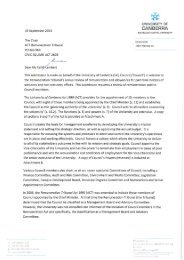
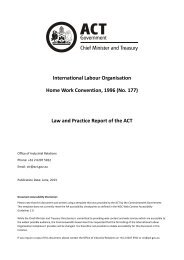
![HSR Training Programs Guidelines [ PDF 191KB]](https://img.yumpu.com/51348280/1/190x245/hsr-training-programs-guidelines-pdf-191kb.jpg?quality=85)


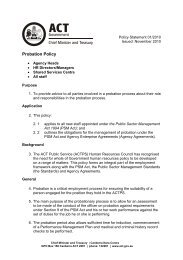

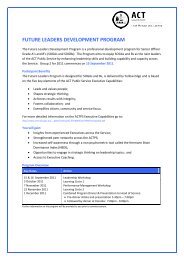
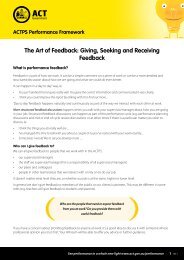
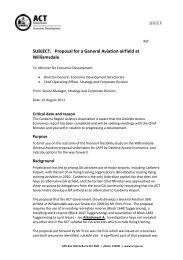
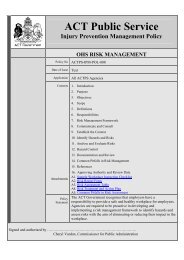
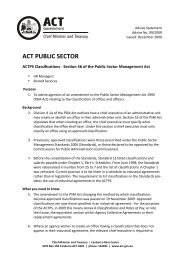
![Teachers Technical and Further Education [ PDF 68KB]](https://img.yumpu.com/34230751/1/184x260/teachers-technical-and-further-education-pdf-68kb.jpg?quality=85)
